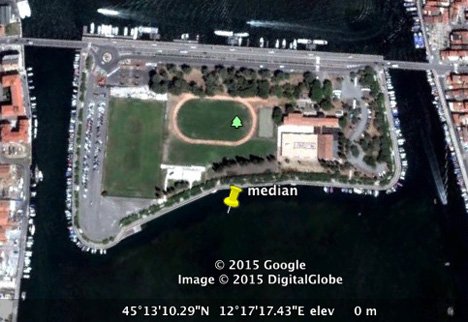2.4.3 - Natural astronomical observatory for the study of the tides.
The particular layout of an island, and of its two lateral channels, proves to have the function of an astronomical observatory, for the study on how the tides are generated.
===========================================================
© copyright notice ||| français ||| italiano
prologue > index tides > 2.4 The cumulative dissipative cycle in water.
2.4.1 The cumulative dissipative cycle in water.
2.4.2 The test Z takes shape.
>2.4.3 A natural astronomical observatory for the tides.
2.4.4 The test Z: amplifying a hidden phenomenon.
2.4.5 The water figures.
2.4.6 Density waves.
2.4.7 Other significant cases.
2.4.8 Ordinary waves and density waves.
2.4.9 For a man-made astronomical observatory for the tides.
===========================================================
Point of observation.
With the set of assumptions of the previous two pages, I chose, as an observation point, the place that seemed most suitable to me: not too far from where I live, and with limited traffic of boats.
It is the lagoon of Lusenzo, located south of the Union island, between Chioggia and Sottomarina, not far from Venice.
The place I chose, to observe the behavior of water, turns out to have a crucial feature for this type of research.
In this lagoon, the water is not stagnant, but is sometimes kept as still as possible. In fact, the water that comes from the sea, and then flows to it, does it through the two channels located on the two sides of the island.

Thanks to the shape of the basin, as the tide changes, water remains for several hours as uncertain as to which channel to pass, either through # 1, or # 2.

In practice, for several hours a day, most of the molecules tend to minimize the movement relative to the surrounding matter. It just moves vertically, and very slowly.
Two of the conditions of the test Z.
Two conditions of the test Z may be met, although rarely: that numerous water molecules are stationary relative to the Earth; and that, at the same time, the same molecules move at one of the critical angular velocities relative to the Moon, for a time long enough to reveal the mechanism, otherwise hidden, through which the tide is generated. Which would be by variation of the water density.
The density variation of many water molecules, at the same time, then manifests itself as “water figures”, arranged in more or less ordered grids.
Series of observations on the behavior of water.
All this led me to consider that the lagoon south of Lusenzo is a natural astronomical observatory, for the study of tides, despite its shortcomings.
The observation program, aimed at identifying discontinuous events in water, started in March 2005. It was then stopped almost entirely in 2011, taking note that some characteristics of the place, chosen for the observations, did not allow, more often than not, the running of the program.
Later, on page 2.4.9, I suggest the characteristics that a place should have, to be considered suitable for the study of how the tides are generated.